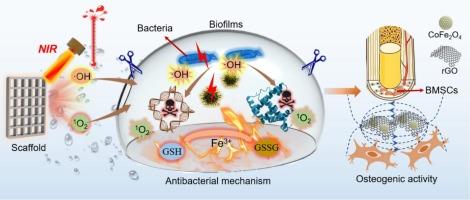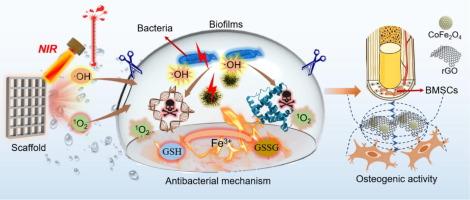双功能钴铁氧体/还原氧化石墨烯异质结增强了支架的抗菌和成骨活性
IF 6.9
2区 材料科学
Q2 CHEMISTRY, PHYSICAL
引用次数: 0
摘要
细菌感染,尤其是生物膜形成的表现,对感染性骨缺损的修复提出了重大挑战。钴铁氧体(CoFe2O4)作为一种产生活性氧(ROS)用于抗菌治疗的光催化剂正在被研究,但它仍然受到光产生的电子-空穴对的超快重组的阻碍。本文通过在还原氧化石墨烯(rGO)上原位生长CoFe2O4,构建了CF@rGO异质结。然后将CF@rGO引入聚l -丙交酯中,采用选择性激光烧结法制备骨支架。特别是氧化石墨烯增强了电子转移,抑制了CoFe2O4中电子-空穴对的重组,从而加速了ROS的产生。同时,氧化石墨烯赋予支架优异的光热性能,能够分散密集的细菌生物膜,促进预生成的ROS渗透到内部,消除深层细菌。此外,由于CoFe2O4产生的内源性磁性微环境和氧化石墨烯较强的非共价结合能力,支架促进了细胞粘附和成骨分化。综上所述,具有抗菌和成骨活性的双功能支架为感染性骨缺损修复提供了一种很有前景的策略。本文章由计算机程序翻译,如有差异,请以英文原文为准。


Bifunctional cobalt ferrite/reduced graphene oxide heterojunction enhances the antibacterial and osteogenic activities of scaffold
Bacterial infection, especially in the manifestation of biofilm formation, poses a major challenge in the repair of infectious bone defects. Cobalt ferrite (CoFe2O4) is being investigated as a photocatalyst for generating Reactive Oxygen Species (ROS) to serve antimicrobial therapy, but it is still impeded by the ultrafast recombination of photogenerated electron-hole pairs. Herein, a CF@rGO heterojunction was constructed by in-situ growth of CoFe2O4 on reduced graphene oxide (rGO). Then, the CF@rGO was introduced into poly-L-lactide to fabricate bone scaffolds using selective laser sintering. Especially, rGO enhanced electron transfer and inhibited recombination of the electron-hole pairs within CoFe2O4, thereby accelerating ROS production. Meanwhile, rGO endowed the scaffold with excellent photothermal properties, capable of dispersing the dense bacterial biofilms and facilitating the infiltration of pre-generated ROS into the interior to eliminate deep bacteria. Additionally, the scaffold promoted cell adhesion and osteogenic differentiation, attributable to the endogenous magnetic microenvironment created by CoFe2O4 and strong non-covalent binding ability of rGO. Summarily, the bifunctional scaffold with antibacterial and osteogenic activities provided a promising strategy for repairing infectious bone defects.
求助全文
通过发布文献求助,成功后即可免费获取论文全文。
去求助
来源期刊

Applied Surface Science
工程技术-材料科学:膜
CiteScore
12.50
自引率
7.50%
发文量
3393
审稿时长
67 days
期刊介绍:
Applied Surface Science covers topics contributing to a better understanding of surfaces, interfaces, nanostructures and their applications. The journal is concerned with scientific research on the atomic and molecular level of material properties determined with specific surface analytical techniques and/or computational methods, as well as the processing of such structures.
 求助内容:
求助内容: 应助结果提醒方式:
应助结果提醒方式:


